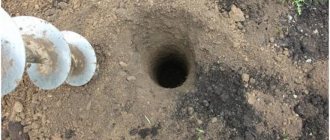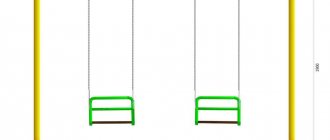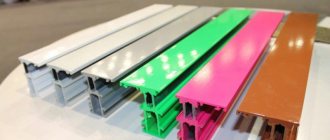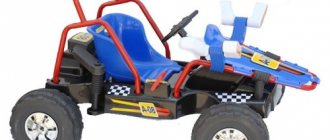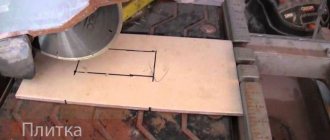If you are the owner of a plot of land, then at least once you have been faced with the need to dig holes for supports and pillars when decorating the appearance of the territory. Sometimes it happens that a hole is needed in a not very convenient place. It is quite difficult to cope with this task with a simple shovel. You can, of course, borrow a hand drill from a friend or call a specialist who can handle the appropriate tool. But if you plan to carry out such work from time to time, then you can make a garden drill for poles with your own hands from scrap materials.
The tool will be easy to use and compact, which is very convenient for storage. Typically, hard metal is used for such work. With its help, you can split plant rhizomes and small stones into pieces. Such a device will allow you to dig a hole by rotating the equipment around an axis like a corkscrew.
Selection of cutting part
The main purpose of the drill is to dig holes. Wells are made with a cutting part, which can have different shapes, namely:
- half-disc shape;
- type of auger;
- two-blade;
- helical;
- removable;
- multi-tiered;
- whole.
If you want to make a pole drill with your own hands, you must determine the design features of the device. Some models have small blades at the bottom, while at the top they increase to larger sizes. By purchasing a factory drill, you will receive an effective and functional tool for use. But it is not always possible to insert it into the soil to the required depth; in addition, the nozzles of such devices may not have the correct diameter.
Drawings and dimensions
The product diagram is a template and allows you to visually estimate how the stages of the manufacturing process of the future tool are located. The dimensions of the garden auger can be as follows:
- handle (if the product is handmade) - crossbar 0.5 m long;
- rod – about 1 m (without additional sections);
- the diameter of the disk cut into pieces is 15-25 cm (reference point is ready-made saw blades for an angle grinder);
- tip length – up to 10 cm (peak or drill);
- the distance on the axis given for the installation of disks (taking into account the slope), after a peak or drill - up to 15 cm;
- The upward tilt angle of the knives is up to 30 degrees.
In an auger drill, the length of the “screw” (a monoblade with several turns) can reach up to half a meter. The tilt of the screw stroke can reach the same 30 degrees (at any point of the monoblade). The remaining parts of the auger drill are the same as those of a simple two-blade drill.
The dimensions of the drill for planting seedlings, such as tomatoes, generally coincide with the dimensions of the working part of an ordinary bayonet shovel. Its cutting edges are trimmed so that the bayonet of the shovel goes from round to straightened and pointed at an obtuse angle. The leaf fold is cut off from the opposite (upper) edge. A long (more than half a meter) concrete drill can be welded into the hole from which the handle is pulled out (under the universal hammer drill clamp). It is advisable to use a drill made from a shovel bayonet with a drive, since for manual drilling it requires more effort than the inclined screw of an auger or half-disc of a conventional garden drill.
A drill of any type can be equipped with additional sections. Each of them increases the depth of soil drilling by a meter. These extension sections are used when the owner decides to drill a well for water himself. One such section is used when the ground is soft. These can be posts for fences and other non-permanent structures, buried to 1.4 - 2 m.
Having decided what kind of hole drill you need, cut out a sketch for the blades from cardboard. It made cutting sheets easier and faster.
Recommendations for the manufacture of individual parts
Before you start making a pole drill with your own hands, you must understand the components of this tool, among them the following should be highlighted:
- baking powder;
- soil receiver;
- shaper plow;
- screw.
The baking powder consists of two planes or a screw. The latter is similar to a spiral; in this unit the knife is located on a rod. There is also a soil receiver in the drill. Soil is collected here, which makes it easier to drill holes with a diameter of up to 35 cm. When making a drill for posts with your own hands, you will need to equip it with a shaper, which will be located in the lower part. This unit allows you to strengthen the columnar foundation, which is required when constructing large buildings.
Drill for making piles
The classic version of a drill for TISE is blades with a container for collecting soil. There is also a wider knife, which is necessary to create an expansion at the bottom of the pile. Using such a homemade drill for personal purposes is not very convenient, since the additional folding knife gets in the way.
In this regard, such structures are often made collapsible, where the folding knife can be dismantled. In general, it is recommended to use a regular garden drill to make a pile for personal purposes, and for expansion, make a separate knife with a container for collecting earth. The work is much easier in this case.
For this design, a scrap from a shovel is used as a knife, and a container for collecting soil can be made from a herring can. The knife is fixed on levers, and when lowered along the pile, it is in the uppermost position, as it is tensioned with a cable. When it reaches the bottom, the cable relaxes and the knife falls onto the walls of the pile, beginning to remove the soil and form an expansion of the desired size.
Alternatively, a dredger can also be made from an old propane tank. To reduce friction, the well is constantly doused with water. This tool can also be used on hard soils.
This is interesting: gas drills for earthworks.
Preparation of materials
If you decide to make a drill for poles with your own hands, then at the first stage you need to start preparing everything you need. Among the details it is worth highlighting:
- nut;
- drill;
- vice;
- pieces of metal pipe.
You will also need an M 20 bolt. You need to take 2 disks with a diameter of 100 to 150 mm. As for the drill, it must have a tip with a diameter of 20 mm. A metal pipe will lie at the base. You will need two sections of 500 mm and one of 400 mm. It is better to take a pipe with a wall thickness of 3.5 mm and an outer diameter of 40 mm. With these parameters, the finished product will be durable and will be able to withstand hard ground.
Making a garden drill
A garden auger is the simplest but most effective design. It consists of:
This is a basic design, and there are many modifications to it. But let's first talk about what an earth drill can be made from.
Materials
As already mentioned, the rod is most often made from a round or square pipe. Diameter - from 3/4′ to 1.5′, profiled pipe can be taken from 20*20 mm to 35*35 mm.
Blade knives can be made from:
It is easier to make blades from a saw blade. In this case, the cutting edges are already ready. It will be possible to further sharpen the side edges to make the soil easier to cut.
The spear-drill is made from different materials - there are many different designs. They just make a sharpened rod. Then you need a piece of large diameter rod. The second option is to make something like a drill from the steel strip. And yet - a combination of these two.
Pike - one of the tip options
And finally - about the pen. It is more convenient if it is made of a round pipe. Its diameter can be selected according to the circumference of the palms. The main requirement is that you should be comfortable.
Knives and fastening method
First of all, you need to decide whether you are making a drill with your own hands with removable or stationary blades. If the blades are removable, weld shelves made of thick steel at one end of the rod. The shelves are made at an angle - so that the planes of the knives are separated at an angle of 25-30°.
After the shelves are welded, two or three holes are made in them for fasteners. Then the same holes will need to be made in the blades, and installed on bolts of substantial diameter.
One rod can have several sets of cutting blades - for holes of different diameters
You will have to cut holes in the center of the disks themselves so that they fit more tightly to the rod, but this operation is also required for the monolithic version - with welded blades.
Sheet steel
If you are going to make the blades from sheet steel, cut out a template from paper and use it to create a circle of steel. Drill a hole in the center - you will need to insert and weld a rod into it. Circle or square - depending on the chosen rod. The hole dimensions are slightly larger than the dimensions of the rod.
The edges should also be separated by 25-30 degrees. In this case, drilling efficiency will be maximum. If you work on dense soils (clay, loams with a predominance of clay), the blades may collapse under load. To avoid this, stops are added from a corner or a thick strip of steel.
The blades bend due to the fact that unhardened steel is used, but it is almost impossible to find it in the sheet, and even if it is possible, it is unlikely to be bent.
From a saw blade
If you have an old saw blade of a suitable diameter, you have found an almost ideal option. They use hardened steel, which is elastic and durable. But such a disk cannot be bent, so it is sawed in half and these halves are placed at the required angle.
This homemade drill for excavation works shows quite high productivity. Even used wheels have a well-ground edge. And to make drilling even easier, they also sharpen the drill on the sides with their own hands.
Modifications
In dense soils, it can be difficult to cut the soil with large blades. In this case, several blades of different sizes are welded onto the rod. From below, near the peak, the smallest ones are welded; above, retreating a few centimeters, the large ones are welded. There can be three such tiers, maximum four. The entire cutting part should not be more than 50 cm, otherwise it is physically very difficult to work.
If a drill is needed for shallow holes - for installing poles, etc., then this design is optimal - it is relatively light in weight and easy to work with. The working process is as follows: they lowered it into the hole, turned it several times, pulled it out, and poured out the soil stuck between the blades. But if you need to drill deep holes, you will suffer from carrying a small amount of soil from the depths. For such cases, a box for collecting soil is welded above the blades.
And all these are hand-made drills. All of them are highly efficient - it’s much easier to work than store-bought ones.
Preparing tools
You can borrow the discs from a regular circular saw or make them yourself. To do this, you should find 3mm sheets of metal. Among the tools that will be needed in the work are:
- angle grinder;
- welding machine;
- metal drills;
- hammer;
- drill.
If you do not have a tip with a drill, you can replace it with a drill with a shank that looks like a cone. Its diameter must match the screw. In order to prevent injury, you should use soft bicycle handles.
DIY hole drill from a hammer drill
Without a doubt, every person who lives in a private house or spends his free time in the country has such a power tool as a hammer drill. Unlike an ordinary electric drill, it has a hammer drilling function.
Thanks to the use of this power tool, you can make holes of different diameters in a hard and durable surface without much effort and in a short period of time. In some cases, to drill holes in the ground under fence posts or piles, a power tool such as a hammer drill is used as a hole drill.
Materials and tools for manufacturing
Sometimes people who live in a private house or are owners of summer houses need to carry out a variety of earthworks.
Often there is a need to dig holes, which are necessary for the further arrangement of fence posts or so-called pile supports.
To perform drilling and carry out similar work, hand tools (drill) are mainly used.
It is worth noting that using hand tools takes a lot of time and requires huge labor costs. In some cases, when there is a need to carry out a large amount of work, digging holes, special equipment is used, which is equipped with an electric or fuel type drive.
The use of special equipment during various excavation works, such as digging holes for pile supports, significantly reduces the amount of labor costs.
However, purchasing or renting such equipment is not cheap.
It is for this reason that a large number of people use homemade hole drills to perform such excavation work, which can be made independently from the most ordinary hammer drill.
As a rule, such homemade drills are used for drilling shallow holes of small diameter. The design of a homemade pit drill consists of the following parts:
- Adapter (a reducer can be used as an alternative).
- An ordinary earthen auger.
- Rotary hammer (it is recommended to use a power tool with a good power reserve).
You can make an earth auger and adapter yourself. However, it should be noted that in construction stores you can purchase a ready-made auger (special attachment), which is designed directly for drilling holes on the ground surface. To make a hole drill yourself you will need to use:
- welding machine;
- angle grinder (grinder);
- hammer drill;
- electric drills;
- metal rod or fittings (used to make a rod);
- material for making the cutting part;
- cable and socket (used to make an extension cord).
For a homemade hole drill, it is recommended to use a power tool with a power of 2 kW or more. It is worth noting that such a device is not recommended for drilling holes in very hard soil. Using a homemade hole drill, drilling can be carried out continuously or with periodic removal of excess soil from the hole.
How to make a hole drill from a hammer drill
The work associated with converting a hammer drill into a device used for making holes in the ground involves only the creation of a special attachment. To create such a nozzle, you must perform the work in the following sequence:
- A grinder is used to cut a piece of tube or ordinary metal rod of the required length (if the power of the hammer drill is 2 kW, you need to cut off 1 m of rod).
- Cutting knives need to be welded to the bottom of the tube. To make knives, you can use a dull circular saw blade. To do this, it needs to be cut in half and welded to the tube at a slight angle (25-30 degrees).
- You need to cut off the base from the hammer drill and weld it to a tube with cutting knives. Thanks to this, the structure can be connected directly to the power tool itself.
After making the nozzle, it must be inserted into the chuck of the power tool. When drilling holes in the ground surface, it is recommended to use minimum speed. It should also be noted that to perform such tasks, it is preferable to use a power tool whose power varies from 2 kW.
Making a hole drill yourself will not take much time and will not require a lot of effort. Thanks to its use, the process of performing excavation work associated with digging small-diameter holes in the ground is significantly simplified and accelerated.
Thanks to the use of this power tool, you can make holes of different diameters in a hard and durable surface without much effort and in a short period of time. In some cases, to drill holes in the ground under fence posts or piles, a power tool such as a hammer drill is used as a hole drill.
Step-by-step work
If you decide to make a manual post drill with your own hands, draw a circle with a center on a metal sheet. This part will be the blade. The circle is cut out with a grinder, after which a cutting line should be drawn along the diameter line. At the next stage, you need to draw a cutout line that will correspond to the circumference of the collar. The disk is divided into two parts, after which a hole for the knob should be cut. At the end of the pipe, which will serve as a wrench, four longitudinal lines must be made with an angle grinder. These are formed into a point using a hammer. In this case, you need to make cuts at the very center of the pipe.
The tip is processed by welding. The driver should not become clogged with soil during operation. When making a drill for fence posts with your own hands, in the next step you will need to connect the disk to the collar using a weld. This is done at a distance of 5 cm between them. It is necessary to maintain the angle of the plane of rotation, which is 20˚.
Types of drills
A drill is a type of construction equipment whose function is to make a hole of the required size. It is used in various fields. For example, in the construction of bridges and fences, for gardening work (when planting trees and other vegetation).
They can be divided into:
- Hand drills. They are often used in everyday life by both beginners and advanced summer residents.
- Designs with automatic drive. Modernized hand drills. A motor is installed on them.
- Mounted. These are the same mechanized drills, only with the possibility of installation on special agricultural equipment (tractors, walk-behind tractors, etc.).
The first ones have the weakest design and purpose. They drill holes of small diameter and depth. Without the effort of the worker, such a tool is useless. But its advantage lies in its compactness, since it is small and light. It is quite convenient to transport it. With this tool you can easily make a hole for a fence or seedlings.
In this video we will look at how to make a hand drill:
It consists of a rod and a T-shaped handle on top of the structure. There is a metal tip at the bottom that performs the function of centering the tool. A little higher is the drilling mechanism itself, designed in a spiral shape. Often consists of 2-3 rows of metal round cutters. As an alternative, use a saw blade as the cutting part.
Power drills are made with a drive system. The design is more complex, but most summer residents can make such a manual drill for poles on their own. The drill also has a metal pipe with a handle, a tip and a cutting part. But an additional motor with a gearbox and drive part is installed. The auger (cutting) part moves due to rotational movements transmitted through gears from a gearbox with a motor.
This design is more powerful, but its strength depends directly on the performance and strength of the motor. The hole can be made deeper, up to 3 meters.
Mounted drills are designed to perform more complex work. The width and length of the holes are much larger. They are often used for the construction of bridges, train stations and other industrial purposes. With their help, you can make sheet piling fences for pits and trenches. Thanks to attachments, the cost of construction work is significantly reduced, as they have greater productivity and power.
https://youtube.com/watch?v=4j8lJtYjAVs
Working on an extension pipe
Next, you can begin working with the extension pipe. It must be equipped with a handle. This part is welded in the shape of the letter T. An amplifier in the form of a scarf is attached to it. The workpiece should be inserted into the driver, making a hole between these parts. This will allow you to fasten the parts with a pin. There should be several holes so that the length of the product can be adjusted. You can complete the work process by sharpening the blades. The edge of the cutter is processed so that when rotating the tip is directed downward.
Application of protective coating
Having made a drill from a pipe for poles with your own hands, you must protect it from external influences and premature aging of the material. This will prevent rust from occurring. The parts of a homemade drill are processed with sandpaper and coated with a primer. A phosphating solution is applied on top. The finished product after this treatment can be painted.
When using a tool, after each use it is usually disassembled and cleaned of dirt and dust. Particular attention should be paid to connections. They are coated with a special lubricant that helps repel water. You should not miss this moment, because proper care will be an excellent prevention of bolt jamming and will allow the equipment to operate uninterruptedly for a long time.
Drill for TISE piles
In the author's version, the TISE drill is a blade with an earth receiver and a folding wider blade, which forms an expansion at the bottom of the pile. But working with such a projectile is inconvenient - the folding knife gets in the way. Therefore, in some designs it is made removable, but in general, it is recommended to drill the holes themselves with an ordinary garden drill, and for expansion, make a separate folding knife with an earth receiver. This makes the work easier and faster.
Do-it-yourself drill for TISE piles - one of the options
A cut-off shovel serves as a knife, and the land receiver is made from a herring can. The knife is fixed movably; when lowered into the pit, it is pulled up by a nylon cable tied to the end. Having reached the bottom, the cable is weakened, the blade begins to trim the sides of the hole, forming the necessary expansion.
The photo below shows the second version of a homemade drill for TISE piles. The design is more complex, but also more effective. The plow blade is made from a piece of spring, sharpened and welded to a folding structure with bolted joints.
More complex design
The dredger is made from an old propane tank. The collection of soil occurs from below, which is why the receiver is made with a rounded bottom. It has two holes, their edges are sharpened.
Bottom view
This projectile works well even on dense clay. True, to reduce friction, the well must be constantly moistened with water.
How to improve the tool
When making your own garden post auger, you can think about improving it. When drilling holes, you may encounter large rhizomes that lie tightly in the ground. Sharp edges make work easier. For ease of use, teeth should be cut on the sloping area of the blade or the cutting part should be rounded.
The design can be improved by adding removable cutters. They will allow you to drill holes of any diameter. In addition to the manufacture of spare parts, it is necessary to provide for their attachment to the collar. They are connected by two iron plates, fixed by welding. Two holes are drilled into the mounting plates and blades for the bolts. The cutters are fixed with M 6 bolts. The bolts may interfere during operation. To eliminate this problem, they are screwed in with the threads facing up.
If you want to make the best DIY post drill, you can improve it using one more method. To do this, a narrow metal plate is cut out and turned into a cone using a grinder. This will improve the efficiency of the lower end of the knob. The dimensions of the plate are 10 x 2 cm. As a result, you should get a kind of point. There is no need to make cuts in the collar. Metal plates are inserted into the end and secured by welding. They are flattened to form a peak.
If you want to use a pike, you can base it on a different method of making it. To do this, take a 17-centimeter metal plate, from which a screw similar to a corkscrew is cut out. The further algorithm of actions will be the same as in the first option.
If you decide to make a pole drill with your own hands, photos of such structures will allow you to understand which design to give preference to. If a screw is provided, a drill can play its role. It should be able to handle wood and metal. Such a tool will penetrate the soil more easily and will drill holes of the required depth.
If you are working with dense deep layers of soil, you can weld a small flat cutter between the cutter and the pick. This design will allow you to loosen the ground and center it when drilling. For such a part, you need two metal plates 3 x 8 cm. A trick of this kind will speed up the work with the tool.
When making a drill for installing pillars with your own hands, you can supplement it with cutters made from disks that are designed for working with stone. The circles are cut along the radius, and the hole widens in the center. It must match the diameter of the knob. Bending the disk allows you to get something like a screw or a corkscrew. This part will only need to be welded using the algorithm described above.
The cutter can be made from a circular saw blade. The teeth will cope with rhizomes and hard soil. You can upgrade the tool at your discretion. But no matter how high-quality it is, before the drilling process it is better to loosen the soil with a shovel, then the device will penetrate the soil well and the work will go faster.
Auger drill
Due to the large number of turns, an auger auger creates significant resistance, that is, it is much more difficult to work with it than with a garden auger. But augers are used mainly in the presence of a mechanized drive - when making a drill for deep wells - for water, for installing underground probes for a heat pump, etc.
This is what an auger drill looks like
To make a homemade auger drill, you will need several metal disks. The number of disks is equal to the number of turns. The disks are cut identically, a hole is cut in them in the center for the rod, as well as an identical sector - so that they can be welded.
A sector is marked in the rings and cut out
The discs are welded on one side, then, slightly stretching the resulting accordion, the seam is welded on the other side. Rings are welded on the outer disks. The welded discs are placed on the rod, the lower edge is welded.
It turns out to be such a big spring
Next you will need a winch. The blank for the auger is secured, the winch hook clings to the ring and is stretched to the required length, after which the auger is boiled.
Almost done
